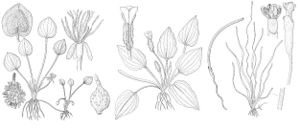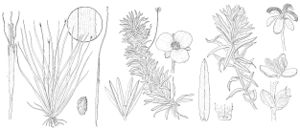Hydrocharitaceae
Herbs, annual or perennial, caulescent or without evident stem, glabrous or pubescent, entirely submersed, with both submersed and floating leaves, or with submersed stolons and emergent leaves, in fresh, brackish, or marine waters; turions rarely present. Stems rhizomatous, creeping, with abbreviated erect axis at nodes, or erect, leafy, elongate. Leaves basal, alternate, opposite, or whorled, sessile or petiolate; stipules sometimes present, forming tubular sheath around stem; blade margins entire or serrate; veins 1–many. Inflorescences axillary, terminal, or scapose, 1-flowered or cymose, subtended by spathe; spathe a 2-fid bract or pair of opposite bracts. Flowers unisexual, staminate and pistillate on same plants or on different plants, often with rudiments of opposite type, or bisexual, actinomorphic, rarely slightly zygomorphic; perianth epigynous, free, mostly 6-parted, then differentiated into sepals and petals, rarely 3-parted, then petals absent in Thalassia and Halophila; stamens (0–)2–many in 1 or more whorls (inner often staminodial), epigynous, distinct or ± connate; pollen spheric, in monads or tetrads or in slender chains; ovary 0–1, if present, inferior, 2–6[–16]-carpellate, 1-locular or falsely 6–9-locular; placentation parietal. Fruits berrylike. Seeds many, fusiform, ellipsoid, ovoid, or spheric; seed coat glabrous, papillose, or echinate.
Distribution
Nearly worldwide.
Discussion
Hydrocharitaceae, like other members of the Alismatidae, have one or more (fewer than 20) scales (intravaginal squamules) in the axils of their leaves. These scales (or hairs in some taxa) secrete mucilage and are without any venation. The structures are often referred to as "squamulae intravaginales" or "intravaginal scales" in the literature.
Genera 17, species ca. 76 (10 genera, 14 species in the flora).
Selected References
Lower Taxa
Illustrations
Key
| 1 | Plants of marine waters; pollen in moniliform chains. | > 2 |
| 1 | Plants of fresh or slightly brackish waters; pollen in monads or tetrads. | > 3 |
| 2 | Leaf-bearing branches arising from rhizomes at distances of several internodes; styles 6–8; fruits echinate, dehiscing into 6–8 irregular valves.es | Thalassia |
| 2 | Leaf-bearing branches arising from rhizome at each node; styles 3–5; fruits smooth or ridged, not echinate, dehiscing by pericarp decay | Halophila |
| 3 | Stems elongate (more than 3 cm), erect; leaves cauline, whorled. | > 4 |
| 3 | Stems short (less than 2 cm) or, if elongate, then stoloniferous; leaves basal. | > 6 |
| 4 | Leaves with prickles along abaxial surface of midvein; intravaginal squamules fringed with orange-brown hairs. | Hydrilla |
| 4 | Leaves without prickles along abaxial surface of midvein; intravaginal scales squamules entire or, if fringed, marginal hairs clear, not orange-brown. | > 5 |
| 5 | Whorls with 5 or more leaves per node. | Egeria |
| 5 | Whorls with 2–4(–7) leaves per node or leaves opposite at proximalmost nodes. | Elodea |
| 6 | Stems floating on or suspended in water; some leaves with aerenchyma on abaxial surface; peduncles mostly short (less than 5 cm). | > 7 |
| 6 | Stems rooted in substrate; leaves without aerenchyma on abaxial surface; peduncles mostly elongate (more than 5 cm). | > 8 |
| 7 | Anthers oval; filaments distinct to base or nearly so; seeds minutely tuberculate or muricate; styles 6, 2-fid less than ½ length. | Hydrocharis |
| 7 | Anthers elongate; filaments connate at least ½ length; seeds echinate; styles 3–9, 2-fid nearly to base. | Limnobium |
| 8 | Leaves petiolate; spathe winged or ribbed. | Ottelia |
| 8 | Leaves sessile; spathe not winged or ribbed. | > 9 |
| 9 | Seeds glabrous; leaves with rows of lacunae on each side of midvein, giving blade 3-zoned appearance of middle, light-colored zone bordered on each side by darker zone; flowers unisexual. | Vallisneria |
| 9 | Seeds echinate; leaves with continuous intercellular spaces, blade of uniform color from margin to margin; flowers bisexual. | Blyxa |


